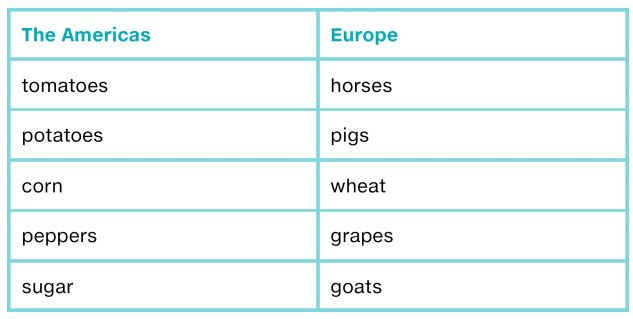A ___________________ gives money to support another person or cause.
Patron
What boat would have been best for a long expedition across an ocean in the 1400s?
A
B
C
D
Boat C
"As soon as I arrived in the Indies, on the first Island which I found, I took some of the natives by force in order that they might learn and might give me information of whatever there is in these parts."
—Christopher Columbus, 1493
Which part of the excerpt shows the negative treatment of American Indians at the hands of European explorers?
A. "As soon as I arrived in the Indies . . ."
B. ". . . on the first island which I found . . ."
C. ". . . I took some of the natives by force . . ."
D. ". . . in order that they . . . might give me information . . ."
C. ". . . I took some of the natives by force . . ."
A person who buys and sells goods for profit is called what?
MERCHANT
A widespread disease.
What was the main goal of Prince Henry’s navigation school?
to find and control trade routes
Which statement does the timeline support?
A. Leif Ericcson opened trade routes to North America.
B. Explorers traveled the same routes for safety.
C. Shipbuilding improved in the fifteenth century.
D. Prince Henry started the age of exploration.
C. Shipbuilding improved in the fifteenth century.
As soon as I arrived in the Indies, on the first Island which I found, I took some of the natives by force in order that they might learn and might give me information of whatever there is in these parts.
-Christopher Columbus, 1493
We now know that Columbus was in the Caribbean when he wrote this. Why does he call the islands “the Indies”?
Columbus sailed west to find a sea route to India. After his long journey, he thought his expedition had reached India. He called the islands “the Indies” and the people there Indians. In fact, he had only reached the America's. India was still half a world away.
The process of planning a route and finding one’s location is known as what?
The movement of people, animals, plants, and cultures between the Eastern and Western hemispheres.
COLUMBIAN EXCHANGE
A(n) ______________________ is a journey or voyage.
Expedition
Look at the picture. Then answer the question.
What negative effect of the Columbian Exchange is shown here?
A. war
B. trade
C. slavery
D. disease
D. disease
Explain a positive outcome of the Columbian Exchange that we can see today.
Cultures were exchanged between different groups. Today there is a greater diversity as a result. Eventually, the flow of goods and people across the ocean led to the large immigrations of people that formed the United States.
What is known as a small, fast sailing ship?
CARAVEL
A settlement ruled by a faraway country (different from an empire, which rules over many lands and colonies).
COLONY
How is a colony different from an empire?
A colony is a settlement or area far from the country that rules it.
A
B
C
D
Which statement makes the best argument for what boat would be best for a long expedition?
A. The boat labeled A is small and is helpful for exploring rivers by the shore.
B. The boat labeled B has a large, square sail and oars that give it two sources of power.
C. The boat labeled C has room to store supplies and different-shaped sails to use the wind better.
D. The boat labeled D has oars and would be needed for sailors to go from the main ship to shore.
C. The boat labeled C has room to store supplies and different-shaped sails to use the wind better.
Arrange the followingEuropeans in the order they came to the Americas:
conquistadors, officials, explorers
explorers --> conquistadors --> officials
This is a person who supports another financially.
PATRON
Are the following effects of the Columbian Exchange positive or negative?
New foods, increased trade, and cultural diversity
POSITIVE
Define the Columbian Exchange.
The movement of people, animals, plants, and cultures between the Eastern and Western hemispheres.
Look at the graphic organizer. Then answer the question.
Which was the cause of the effect in the graphic organizer?
A. Spain wanted to create jobs.
B. Spain needed money to pay for wars.
C. Spain wanted to move its government.
D. Spain needed to defend itself from American Indians.
B. Spain needed money to pay for wars.
Name two items that were traded from the Americans to Europe using this chart.
answers can include: tomatoes, potatoes, corn, peppers, and sugar
A conqueror, especially one of the Spanish conquerors in North or South America in the 1500s.
CONQUISTADOR
Are the following effects of the Columbian Exchange positive or negative?
Disease, slavery, and forced labor on plantations
NEGATIVE